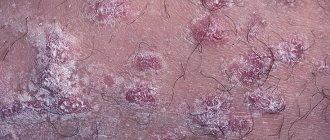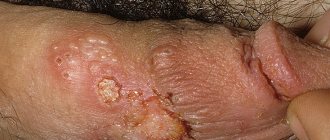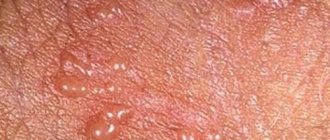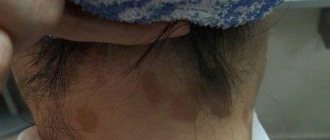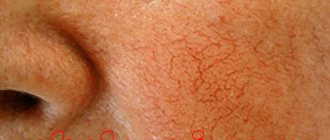Blisters in the groin with herpes type 2
The most likely cause of a vesicular rash is a herpes infection.
It is considered one of the most common STDs, ranking second after trichomoniasis.
Blisters in the groin area do not appear immediately after infection.
The incubation period lasts for 1 week.
This is the time that passes from the moment of sexual contact with an infected partner until the first symptoms appear.
These are the subjective sensations: itching, burning, tingling.
This is the prodromal period, when there is no rash yet.
She appears a day later.
Watery blisters form in the groin, surrounded by an area of hyperemia.
They contain a clear liquid.
Vesicles are grouped.
Almost all of them are formed at the same time.
In the future, if there are any additions, they are insignificant.
Bubbles appear wherever the virus enters the skin.
This can be not only the groin area, but also the labia majora, pubis, and anal area.
In men, watery blisters in the groin are complemented by a vesicular rash on the head of the penis and scrotum.
After a few days the contents become cloudy.
The bubbles become sluggish.
Then they open up.
Ulcers form, which transform into crusts.
After they leave, temporary hyperpigmentation remains.
Herpes infection is not completely cured.
Although its symptoms go away after 1-2 weeks, the virus remains in the body.
Existing drugs do not allow for its complete elimination.
Therefore, for most people, herpes recurs from time to time.
Features of relapses:
- are milder than the primary infection
- may vary in frequency among individuals, occurring within 80% within 12 months of infection
- the severity and frequency of exacerbations correlates with the severity of the initial episode of the disease
How herpes will progress largely depends on the full functioning of the immune system.
In people with strong immunity, bubbles may form in small quantities and last only a few days.
The illness lasts only a few days.
In the future, there are no exacerbations at all, or they are so mild that they go unnoticed.
In people with weak immune systems, the disease is severe and often worsens.
HIV-infected people may experience severe complications, including those associated with brain damage.
Why do they appear
Pubic blisters can form in men and women for a variety of reasons. Among the main factors in medicine, it is customary to highlight the following:
- Pubic lice bites - parasites bite delicate skin. As a result, a person feels severe itching, ulcers similar to blisters appear on the pubis;
- blisters after shaving are one of the common causes. Microtraumas appear on the pubic skin; this is a favorable environment for the growth of bacteria. Sometimes people develop allergies to cosmetics, which also contributes to the appearance of ulcers;
- psoriasis is a serious autoimmune disease. It affects any part of the skin and can also be localized in the pubic area. The skin cracks, dries, hurts a lot, and ulcers appear on it. The disease is considered incurable, but it is possible to put it into a stage of long-term remission. Often, exacerbation is provoked by severe stressful situations;
- Genital herpes is a common disease that causes blisters and sores. After infection, ulcers appear on the pubis of women and men. Inside the papules there is purulent or clear liquid. After maturation, the abscesses burst and fluid flows out. A crust forms in their place. Genital herpes is usually transmitted through unprotected sex;
- Scabies is a disease caused by parasites, scabies mites. They get on the skin of a healthy person and settle in the upper layers of the epidermis. Ticks gnaw passages in the skin and deposit excrement. The body responds with an allergic reaction, itching and the appearance of ulcers. Scabies appears in places where the skin is most delicate - the pubis, between the fingers and toes, in the interelbow folds;
- cyst – blockage of the sebaceous gland causes the appearance of a cyst. This is a large subcutaneous white pimple found on the labia, pubis or glans penis. The cyst grows, reaches a large size and begins to hurt very much. You cannot squeeze it out yourself, so as not to cause an infection. The blister is surgically removed.
Are blisters in the groin dangerous due to herpes during pregnancy?
A herpetic infection is extremely unpleasant for most people, but still not dangerous.
But if blisters in a woman’s groin occur during an existing pregnancy, this is an unfavorable prognostic sign.
Surely you know that all expectant mothers are tested for TORCH infections in the first trimester.
The letter “H” in this abbreviation stands for herpes.
This is one of the most dangerous infections of the gestational period.
It can lead to spontaneous abortion, developmental defects, complicated pregnancy, and premature birth.
Sometimes the fetus becomes infected with a herpes infection and develops severe neonatal herpes.
The greatest threat is when a woman becomes infected after conceiving a child.
While a recurrence of herpes is much safer for both the mother and the fetus.
In this case, protective antibodies exist in the blood.
Therefore, although there are risks, they are minimal.
How do you know if you are infected for the first time, or if this is an exacerbation of herpes that you may have been infected with many years ago?
First, you can strain your memory and remember if you have had blisters in your groin before.
Secondly, you must be tested for antibodies to herpes during pregnancy.
If there are IgG antibodies, but not IgM, this is a relapse of herpes, and not a primary infection.
In case of relapse, the risk of intrauterine infection is very small.
But there is a risk of transmitting herpes to the newborn during childbirth.
Therefore, all women who develop blisters in the groin in late pregnancy are subject to drug treatment.
In some cases, the presence of genital herpes becomes an indication for cesarean section.
Otherwise, the child becomes infected.
In the natural course of neonatal herpes, the mortality rate of children reaches 50%.
In the case of the development of a disseminated form of infection, it is even higher – 90%.
After treatment, children usually survive, but neurological impairment may persist.
Blisters in the groin due to heat rash
Miliaria is a reaction of the groin skin to overheating.
There is a blockage of the sweat glands.
Miliaria can be crystalline and red.
In the case of crystalline prickly heat, blockage of the sweat glands occurs at the level of the stratum corneum of the skin.
In this case, small bubbles with transparent contents are formed.
Usually they do not exceed 1 mm in diameter.
Miliaria rubra is an even deeper process.
Therefore, in addition to the blisters, papules appear.
Miliaria itself is not considered a disease.
This is nothing more than a skin reaction to overheating and humidity.
After eliminating the pathogenetic factors, the skin is restored without treatment.
But prickly heat is a predisposing factor for secondary infections.
If bacterial flora attaches, sweat gland abscesses can form.
They require surgical treatment.
Blisters in the groin due to dermatitis
Contact dermatitis can cause blisters to form.
This is a form of skin inflammation that is associated with exposure to a toxic substance.
Most often, contact dermatitis occurs on the hands and is associated with work activities.
If bubbles appear in the groin, we are not talking about occupational hazards.
With a high probability, such a lesion is caused by attempts at self-medication, when all kinds of “folk recipes” are used.
Sometimes people try to remove warts and moles with caustic chemical compounds containing alkalis or acids.
The acute form of contact dermatitis develops with short-term exposure to a chemical substance in a toxic dose.
Plaques appear on which there are many small bubbles located nearby.
Some of them are opened.
Therefore, an erosive surface is formed, from which the ichor is released.
Subsequently, the surface dries out and crusts form on it.
Dermatitis can also occur in subacute or chronic form.
But they are not accompanied by the formation of bubbles.
Blisters in the groin due to allergies
An allergic skin reaction is very similar to simple contact dermatitis.
The only difference is that after the skin reddens, papules first appear on it, and only after that do they turn into blisters.
While there are no papules on the skin upon contact with a toxic chemical, blisters form immediately.
An allergy that appears only in the groin and nowhere else is highly likely to have resulted from direct skin contact with an allergen.
The inflammation zone repeats the area where the substance that provoked the reaction came into contact with the skin.
Unlike simple contact dermatitis, the blisters extend somewhat beyond the area of its impact.
Reasons for appearance
The appearance of redness and rash in the groin in men can be caused by a variety of reasons - from rubbing with tight underwear and allergies to hygiene products to chronic diseases or acute infections.
Most often, such pathological changes in the skin are caused by:
- wearing uncomfortable, rough or ill-fitting underwear;
- excessive sweating;
- failure to comply with hygiene rules, use of irritating hygiene products;
- skin diseases (candidiasis, dermatitis, psoriasis, etc.);
- STD (syphilis);
- obesity;
- diabetes mellitus;
- neuroses, stressful situations;
- allergic reactions;
- long-term use of antibiotics;
- decreased immunity.
The most common and most harmless cause of redness of the skin in the groin area in men is improperly selected synthetic underwear and poor hygiene, especially in hot weather, when sweating increases greatly.
A venereologist talks about the causes of redness in the groin in men.
Linen and hygiene
Potential triggers for redness and rashes in the groin in men include tight synthetic underpants. Wearing them leads to the formation of abrasions, followed by infection and spread of the rash.
Synthetics, closely adjacent to the body, contribute to the occurrence of such negative processes:
- allergic reactions;
- irritation, abrasions;
- increased sweating;
- development of pathogenic bacteria.
Most often in such cases, the groin area is affected in men who neglect personal hygiene. Sweat and other skin secretions accumulate in the folds of the skin, mix with dirt and activate the development of bacteria. This leads to inflammation of even the slightest abrasions and further development of infection.
In addition, rashes in the groin may appear even with careful hygiene procedures if unsuitable detergents are used. They can dry out the skin excessively or cause an allergic reaction, which is also manifested by redness of the skin and the appearance of various rashes.
Also, the cause of such lesions can be overweight or diabetes. In such cases, irritation in the groin area is not accompanied by itching and is essentially diaper rash. This inflammatory lesion occurs due to excessive friction or constant moisture of the skin. Diaper rash initially manifests itself only as redness with a slight burning sensation, spreading symmetrically on both sides of the skin fold. Then erosions may form and secondary infections may occur.
Dermatitis
Inguinal dermatitis in men develops under the influence of mechanical, chemical or biological factors, the main of which are:
- allergies to hygiene products and detergents;
- consequences of wearing synthetic underwear;
- diabetes;
- infectious diseases.
Another type of dermatitis affecting the groin area - perianal - begins with inflammation around the anus and manifests itself with similar symptoms, which over time spread to the perineum and the entire groin. In men, this disease develops due to:
- intestinal microflora disorders;
- diseases of the rectum;
- hemorrhoids, anal fissures:
- prolonged diarrhea;
- poor hygiene;
- urinary or fecal incontinence;
- inflammatory diseases of the gastrointestinal tract;
- damage to the skin around the anus and its infection;
- constant use of a car (Jeep disease), which leads to the penetration of broken hair into the skin around the anus;
- HIV infections, AIDS;
- long-term antibiotic or hormonal therapy.
In addition to general symptoms, each type of groin dermatitis in men manifests itself with specific symptoms:
- bacterial - the formation of purulent blisters, erosions, weeping areas, crusts;
- fungal - the presence of scalloped rims of the affected area, flaky surface, white plaque, pustules and blisters along the edges;
- allergic - severe itching, the appearance of nodules with transparent yellowish contents, which, when opened, form erosive areas;
- perianal abscess fistulous (Jeep disease) - the development of recurrent foci of inflammation and the formation of fistulas in the tissues of the anus.
Seborrheic dermatitis is also a common cause of damage to the groin area in men. This is a chronic disease, usually worsening in autumn and winter and manifested by an itchy, pinpoint rash.
Note! Dermatitis in the groin in men, regardless of the type and causes of its occurrence, extends to the entire groin area. The disease is manifested by redness, the formation of a blistering rash, swelling, swelling and hyperthermia of the affected area.
Mycoses
If redness and rash in the groin in men are accompanied by itching, most often their cause is fungal infections. The most common of them include:
- Athlete's inguinal infection is transmitted through household contact or through normal contact. The risk of infection increases especially in case of poor personal hygiene, excessive sweating or skin damage. The disease manifests itself as red spots edged with an inflamed, swollen rim covered with small scales. Closer to the center of the spot, there are practically no signs of inflammation, and the shape becomes ring-shaped. In addition to spots on the body, there are rashes located in random order.
- Rubromycosis is a fungal infection transmitted through contact with a sick person or contaminated public objects. A characteristic difference between rubromycosis and the previous disease is the dotted appearance of the rim and the absence of rashes on the body.
- Candidiasis of the inguinal folds is caused by an opportunistic fungus that lives on the skin and becomes active when the immune system is weakened. It first appears as redness and swelling of the affected area, which eventually develops into a blistering rash. Then the opening blisters unite into weeping erosive areas with single papules along the edges.
Bubbles in the groin with pemphigus
Pemphigus is a severe autoimmune disease.
Without treatment, deaths are common.
In most cases, the oral mucosa is primarily affected.
Subsequently, blisters appear throughout the body, including in the groin.
There is no itching.
Blisters on the skin cause pain.
The most typical places for the rash to form:
- scalp
- armpits
- groin
- face
- breast
After the blisters open, painful erosions form.
The elements have different sizes and shapes.
They are arranged randomly.
When you press on the bubble with your finger, its area increases (Nikolsky's symptom).
The disease requires the use of immunosuppressants.
Blisters in the groin due to an STD
Most sexually transmitted infections do not cause blisters in the groin.
The exception is herpes.
Much less often, blisters with purulent contents appear against the background of candidiasis.
Other STDs mostly affect not the skin, but the urethra and internal genital organs.
But sexually transmitted diseases are not only infectious, but also parasitic.
Among them is scabies.
It is caused by the scabies mite.
People become infected through sexual intercourse or through bedding.
There are two main complaints:
- itching
- rash
The rash usually appears as papules.
If bubbles appear, they are caused by a secondary bacterial infection.
They can occur if streptococcus is attached.
Then blisters with flaccid lining and purulent contents appear on the skin.
Pubic blisters: photos, causes, treatment
The pubic area is characterized by a large number of hair follicles, sebaceous and sweat glands. The skin in this place requires special attention, since it is in close proximity to the inguinal folds and external genitalia, where, as is known, the most favorable environment for the development of various infectious processes. Considering the characteristics of this area, it is understandable that blisters and other rashes often appear on the pubis, not always of an infectious or fungal nature.
What tests should I take for blisters in the groin?
To understand why the bubbles appear, you need to get tested.
The doctor takes a scraping from the rash.
The material is examined using the bacterioscopic method.
It may contain mites, fungi or other pathogens.
Signs of a bacterial infection (for example, streptococcal pyoderma) are also determined.
The most likely cause of the blisters is herpes.
PCR is used to detect the virus.
It allows you to get ahead of the type of herpes virus (first or second).
Often the blisters are caused by allergic reactions.
A doctor can confirm the allergic origin of skin inflammation using a blood test.
In the future, it is important to identify the allergen in order to eliminate further contact with it.
For this purpose, allergy tests are carried out.
But they do this not immediately, but after eliminating the symptoms of skin inflammation.
The person comes to the clinic after 2 weeks.
Various allergens are applied to the skin and the reaction to them is assessed.
If dermatological diseases are suspected, a skin biopsy may be required to verify the diagnosis.
Why do pubic blisters appear and what to do about them?
The pubis has delicate skin with an abundance of hair follicles. In addition to everything, lymph nodes, inguinal folds, and mucous membranes are located near the pubic area. In case of insufficient care, dermatological or infectious diseases.
Pubic blisters are a common problem. They can appear not only in an adult, but also in a teenager.
If ulcers appear, you should consult a doctor. Self-medication leads to a blurring of symptoms, the disease flows into a latent phase, and can become chronic.
How to anoint the blisters in the groin?
There is no universal ointment that can be applied to the skin and all blisters will go away, regardless of the reasons for their occurrence.
There are a large number of diseases that lead to the formation of vesicles in the groin.
They are all treated differently.
Moreover: the wrong choice of therapy can lead to serious complications.
For example, if a person is trying to treat his allergies, but he actually has streptococcal pyoderma, this will most likely lead to the formation of deep inflammation and an abscess.
Because the antiallergic drugs used suppress the immune system.
The use of antibacterial drugs against the background of an existing fungal infection can aggravate its manifestations.
Because competitors of the fungal flora that inhibit its growth are destroyed.
Thus, therapy can only be prescribed after a thorough diagnosis, otherwise it can be harmful.
If a herpes infection is detected, therapy is carried out with acyclic nucleosides.
The patient is prescribed oral administration of acyclovir or its analogues.
Its use begins as early as possible, ideally during the period of prodromal phenomena.
It is also possible to use topical acyclovir in addition to systemic therapy.
In the future, this drug is prescribed for each relapse of herpes.
For bacterial skin infections, antibiotic ointments are used.
If the depth of inflammation increases, oral antibacterial drugs are indicated.
Streptococcal pyoderma, which causes blisters in the groin, is easy to treat in most cases because streptococci are susceptible to most antibiotics, including penicillins.
For scabies, insecticides are prescribed topically and treatment of clothing and bed linen.
In case of allergy development, local glucocorticoids are used.
Be sure to identify the allergen and eliminate contact with it.
How to treat
Therapy depends on the disease and the type of pathogen. Initially, you need to seek help from a doctor - a dermatologist, gynecologist or venereologist. The doctor conducts a visual examination, collects anamnesis, and prescribes the necessary laboratory tests. Once the results are received, a diagnosis will be made.
- Treatment of genital herpes lasts from two weeks to two months. Patients are prescribed antiviral drugs - Acyclovir, Valacyclovir. Additionally, you need to take a vitamin complex and immunomodulators. In parallel with the use of tablets, you need to use local ointments - Zovirax, Panavir. Complex treatment helps to cope with ulcers, and the disease goes into remission for a long time.
- Sebaceous cysts and boils are usually removed surgically. The doctor gives an injection, opens the cavity of the abscess under local anesthesia and cleans it. Then stitches are applied if the pimple is large. The patient is recommended to take a five or seven-day course of antibiotics, this will avoid complications. Surgery allows you to get rid of the blister permanently.
- When diagnosing scabies, it is necessary to use local remedies. Usually these are ointments that cause the death of parasites. They are produced on the basis of benzyl benzoate. Sulfur ointment and products with pyrethroids also help in therapy. Additionally, it is necessary to maintain personal hygiene and change underwear regularly. Before starting treatment, it is necessary to disinfect bedding and clothing to destroy all larvae.
- For head lice, topical preparations based on permethrin or phenothrin are used. Additionally, household items are treated with special sprays to kill lice.
- If blisters in women or men are caused by allergies, then it is necessary to limit contact with irritants and take antihistamines: Zodak, Zyrtec, Suprastin. The duration of the course and dosage are prescribed by the attending physician.
- Psoriasis requires regular comprehensive treatment. Tablets for oral administration and ointments for topical use (they are used to lubricate plaques) are prescribed as medications.
It is not recommended to treat acne with traditional methods, since they will not be able to influence the causative agent of the disease. If necessary, it is allowed to use folk advice as an additional treatment, but after consulting a doctor.
Conclusion
Pubic ulcers in men and women cause unpleasant symptoms, they depend on the specific disease. The ulcers hurt, itch, and cause discomfort when walking. Treatment is prescribed depending on the disease and the microorganisms that caused the blisters.
For bacterial infections, antibiotics are used, for viral infections, antiviral agents are used. If we are talking about fungal diseases, then antimycotic ointments are prescribed.


